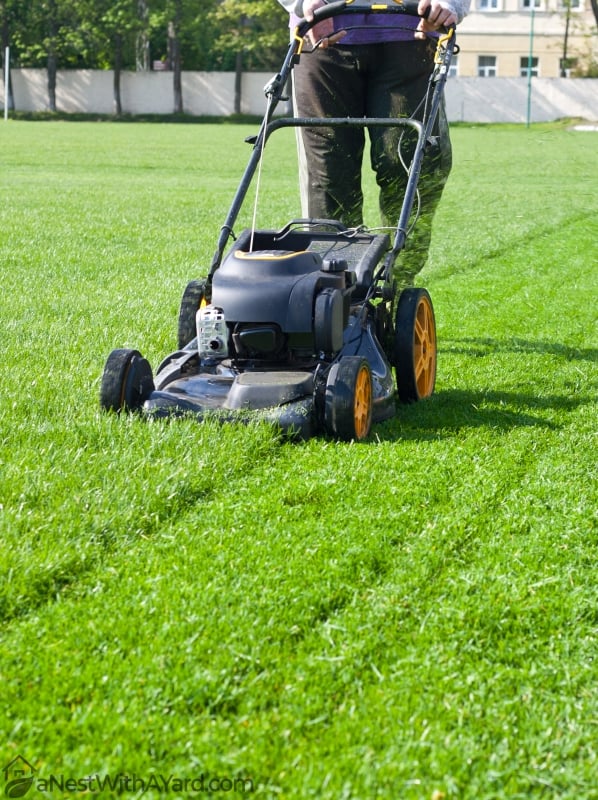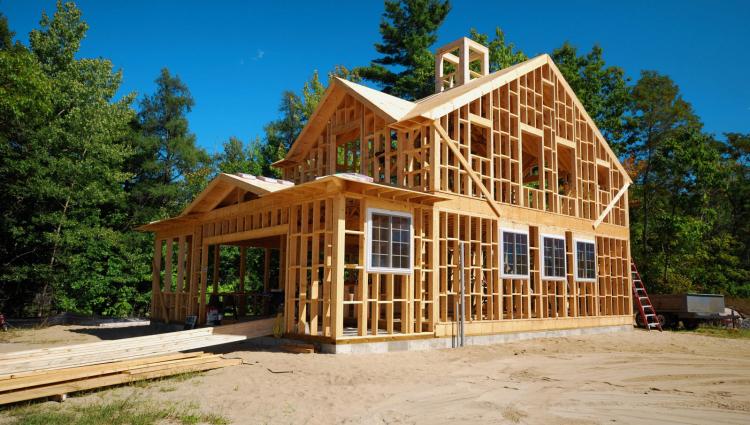
You should cut your grass down to around 2.5 inches in height before winter. It should be the shortest height you have all season, but not too short that the grass isn’t able to photosynthesize and carry nutrients to the roots. If it’s too long, frost could cause it to become matted.
It’s that time of year again when the leaves start changing color and the temperature starts to drop. For many people, this also means it’s time to start cutting the grass blade shorter before winter season sets in. But how short should you cut it?
This is a question that many homeowners struggle with every year. The answer, of course, depends on your geographical location and the weather conditions in your area. Keep reading to find out more about the best practices for mowing grass before winter season sets in and how cool season grasses and warm season grasses affect mowing.
Cutting Grass Before Winter Months

If you live in an area with a lot of snowfall, it’s important to take measures to protect your lawn from snow mold. Snow mold is a type of fungi that can grow on grass blades and other organic matter. It thrives in wet, cold conditions and can cause the grass to turn brown or yellow. The best way to prevent snow mold is to keep grass short during the fall and winter months.
Cutting your grass to a nice short height before the cold weather kicks in helps to give you a healthier lawn come spring. It helps with the prevention of diseases, creates less debris and, as mentioned above, lessens your potential of getting snow mold.
This is an important task as timing is essential when deciding on when to do your last cut before the winter months. You should definitely cut your grass before winter, but there are a number of things you need to take into consideration when it comes to timing:
Type Of Grass

There are two main grass types: cool season grasses and warm season grasses. Cool season grasses, such as Kentucky bluegrass, should be mowed before winter to around 2.5 inches in height, while warm season grasses, such as Bermuda grass, should be mowed to around 1.5 inches.
Grass Height

The height you should cut your grass for its final cut prior to winter can depend on the type of grass you have. Your last cut will likely end up being the shortest height you’ve cut it all year.
If you cut your grass too short, you could cause your grass to go into shock due to the cold temperature and make it more difficult for photosynthesis. For this reason, you should avoid cutting off more than one-third at a single time. On the flip side, if you leave your grass too long, you leave your lawn open to a higher chance of developing snow mold.
Gradual Mowing

It is best practice to cut your grass shorter in stages leading up to that final cut before winter rather than cutting it short all at once. Each time you mow, you should lower your blade height until your final mow reaches the recommended grass height.
Temperature

Most species of grass begin going dormant once temperatures fall consistently below 50 degrees Fahrenheit. This is why it is important that you cut your grass while the weather is still nice and warm. It is best to avoid cutting your grass once the temperatures drop below the 40-degree Fahrenheit mark.
Cool season grasses stop growing once the temperature drops below 50 degrees Fahrenheit while your warm season grasses stop growing once the temperatures reach below 60 degrees Fahrenheit.
Timing
Timing is essential. It is possible to end up damaging your grass if you cut it too late in the season. You need to ensure that you are checking for when the first frost is anticipated as the temperatures start to drop. This will give you time to make sure you can cut your grass down short in stages rather than giving it a big cut at once.
When Will Your Grass Stop Growing?
While grass gets energy from the sun, water from the soil and carbon dioxide from the air to help it grow, as the winter season approaches, your grass enters a dormant period. This is to protect itself from the extreme temperatures ahead.
As your temperature during the day starts to drop below 40 to 50 degrees Fahrenheit, your grass will start to slow down in its growth. This temperature dip may take place earlier or later in the year depending on the region you stay in.
This video by YouTube user Lawn Solutions Australia explains why some types of grasses stop growing in winter:
What To Do When Frost Comes
It is entirely possible to time the last mow before winter incorrectly so you are likely wondering whether you can mow your grass after frost has started. It is recommended that you avoid mowing after frost, as it freezes the moisture contained inside the blades of grass which, in turn, can cause the blades to break and damage the lawn if there is any activity on the grass.
Your frozen grass can be damaged by a number of things, from something as simple as being walked on to being mowed. This is why it is not ideal for you to mow your grass during cold temperatures.
If you cannot avoid mowing your lawn after a frost, you need to make sure that there is not a lot of moisture on your lawn from the ice or snow and choose a warmer day to mow. The day you choose should be hot enough that the frost on your lawn melts and your grass has been able to dry up.
Check out the video below by YouTube user Ryan Knorr Lawn Care about mowing frozen grass:
Lawn Care After Your Last Mow
It is important to give your grass time to recover over winter once you have completed your last mow. Mowing your lawn too much can be detrimental at any time of the year, but it is especially damaging after your grass has entered its dormant period.
You still need to continue to care for your lawn once you’ve stopped mowing. To give your grass the best chance of surviving its dormant period, you will need to ensure that you rake up your leaves, grass clippings, and pine needles, as well as other debris such as rocks and organic matter, as decaying organic matter can be harmful to your grass.
Overseeded your lawn and not sure when’s the best time to mow it without interfering with new growth? Check this out!
FAQs
Should I Cut Grass Short Before Winter?
You should cut grass short before winter. Cutting grass short before winter will reduce the chances of snow mold, prevent diseases and attract less debris. You should ideally cut it short progressively and not more than one-third at a time to avoid shock.
When Should I Cut My Grass Last Before Winter?
You should cut your grass last before winter at the end of October or early November. If you live in a warm area, you could potentially wait until the beginning of December. A general rule of thumb is to cut your grass when temperatures drop below 50°F during the day.
Is It Better To Leave Your Lawn Long Or Short For Winter?
It is better to leave your lawn short for winter. The ideal grass blade length at the start of winter is 2- 2.5 inches. If it’s taller than that, you could risk getting snow mold, and if it’s shorter, your lawn could get stressed out by the cold.
What Happens If You Leave Your Grass Long Over Winter?
If you leave your grass long over winter, it will retain moisture and grow mold. Longer grass is likely to lead to winter kill, smother itself and attract diseases. Long grass can also get matted very easily.
Can I Cut My Grass In November?
You can cut your grass in November. The ideal time to cut grass before the cold weather is late October to early November. However, if you’ve already cut your grass when your average temperatures dropped to below 50°F during the day, there’s no need for you to cut it again.
Is It OK To Mow The Lawn In October?
It is OK to mow the lawn in October. October will most likely be your last month of regular mowing the lawn until winter is over as grass will grow fairly slowly until then.
Now You Know How Short To Cut Grass In Time For Winter
Mowing grass short in winter is the best way to keep your lawn healthy and thriving long after the cold weather has passed. Now that you have a good understanding of how to prepare your grass before winter, you won’t have to stress about snow mold and other nuisances interfering with your beautiful lawn over the winter!
I hope you found this article helpful. Please leave us a comment below and share this with a friend if you did!







